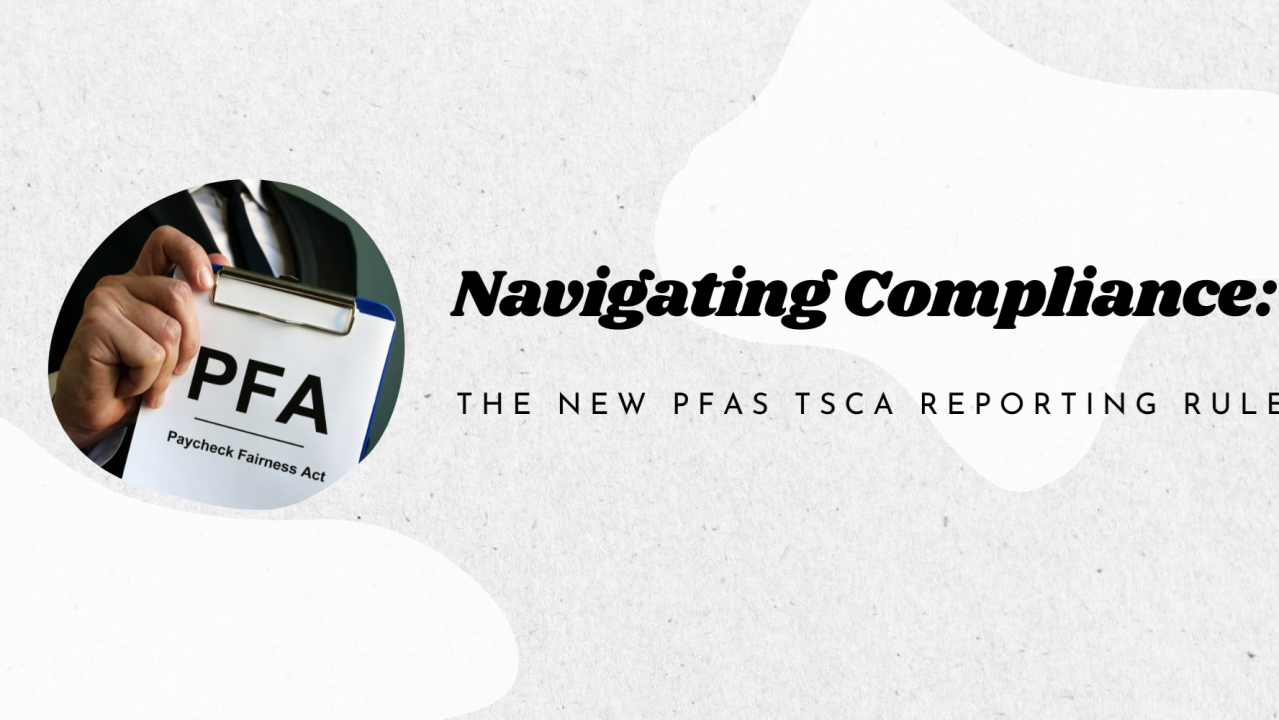
Decoding the New PFAS TSCA Reporting Rule: Navigating Compliance and Industry Impact
Apoorva Goel
MS Environmental, MS Chemical Engineer | Water Treatment | Research | Sustainability | Canada PR Holder
Understanding the New PFAS TSCA Reporting Rule
In a significant move to enhance transparency, the U.S. Environmental Protection Agency (EPA) has unveiled a transformative new one-time reporting rule under Section 8(a)(7) of the Toxic Substances Control Act (TSCA) focused on per- and polyfluoroalkyl substances (PFAS). This rule, finalized in October 2023, is a pivotal compliance milestone, aiming to illuminate the presence and impact of these persistent chemicals across various industries. Beginning in November 2024, manufacturers and importers of PFAS must submit comprehensive reports detailing their PFAS activities since 2011.
Background on TSCA and PFAS Regulations
The TSCA, established in 1976, empowers the EPA to oversee chemical substances, mandating reporting, record-keeping, and testing. Over the years, TSCA has evolved to address emerging chemical concerns, notably the regulation of PFAS due to their persistence and potential health risks.
Known for their durability and resistance to water, grease, and stains, PFAS are used in a wide array of products, including firefighting foams, textile coatings, electronics, and even household items like cookware and toys. EPA’s new rule under TSCA Section 8(a)(7) is part of a broader effort to build a comprehensive PFAS database to better understand their presence in commerce and address potential exposure and contamination risks. ?
The One-Time PFAS Reporting Rule
What is the Rule?
The new rule requires any entity that has manufactured or imported PFAS or PFAS-containing articles to report detailed information on those PFAS to the EPA for each year since January 1, 2011. This encompasses chemical identity, production volumes, usage categories, manufacturing byproducts, disposal methods, worker exposure, and potential environmental or health hazards. Importantly, this is a one-time reporting requirement separate from the typical four-year TSCA Chemical Data Reporting (CDR) cycle. Additionally, entities must maintain records for five years following the submission date.
What Substances are Covered?
The rule mandates reporting on each PFAS chemical substance manufactured or imported for commercial use in the U.S., including those in mixtures, byproducts, and impurities. However, it excludes materials not classified as "chemical substances" under TSCA Section 3(2)(B). To determine which PFAS are included, the EPA uses a specific structural definition:
1.????? R-(CF2)-CF(R′)R″, where both the CF2 and CF moieties are saturated carbons.
2.????? R-CF2OCF2-R′, where R and R′ can either be F, O, or saturated carbons.
3.????? CF3C(CF3)R′R″, where R′ and R″ can either be F or saturated carbons
According to the current EPA CompTox database, this rule covers an estimated 13,000 unique PFAS chemicals. However, even if a PFAS is not explicitly listed on the EPA CompTox list, it must be reported if it fits the structural definition and has been commercially produced since 2011.
领英推荐
What Industries are Covered?
This rule casts a wide net, affecting all manufacturers and importers of PFAS and PFAS-containing articles across diverse industries, irrespective of their size. This includes sectors such as chemical manufacturing, textiles, electronics, automotive parts, construction, wholesale and retail trade, and waste management and remediation services. Essentially, any industry that produces, imports, or inadvertently creates PFAS as byproducts or impurities falls under this rule.
However, the rule exempts non-commercial research and development activities. Facilities solely involved in processing, distributing, using, or disposing of PFAS, without manufacturing them, are not required to report unless they also engage in commercial manufacturing. Waste management operations that import municipal solid waste for disposal are not covered, but those importing PFAS-containing waste for recycling or non-municipal waste streams must comply.
Are There Any Exemptions?
This reporting rule is comprehensive, offering no exemptions based on production volume, PFAS contained in articles, or other typical criteria. While there are no production volume thresholds, small manufacturers whose reporting duties stem solely from article imports benefit from extended deadlines. Additionally, while article importers are not exempt from this rule, they may be eligible for a streamlined reporting option.
What are the timelines?
The reporting window opens on July 11, 2025, with submissions due by January 22, 2026. Small manufacturers importing articles have until July 11, 2026, to submit their reports.
Navigating the Reporting Process
Data Review
Under TSCA, facilities are required to utilize all data that is “known to or reasonably ascertainable by,”, which means all information in a person’s possession or control, plus all information that a reasonable person similarly situated might be expected to possess, control, or know.? To fulfill that obligation, facilities that expect or suspect the current or historical usage of PFAS should examine their supply chains and historical records for any PFAS manufacturing or importing activities since 2011. This involves collecting data from purchase records, Safety Data Sheets (SDS), and possibly consulting with suppliers to confirm PFAS content and usage. A comprehensive inquiry within their organization is expected and may require input from external sources as well, such as upstream suppliers or downstream users, to address any information gaps.
Electronic Reporting
All data must be submitted electronically via the Central Data Exchange (CDX) system. Facilities need to register with the CDX and use the specific web-based reporting tool for TSCA Section 8(a)(7).
Key Takeaway
As the regulatory framework continues to expand, even industries not traditionally linked to PFAS may find themselves affected, potentially uncovering trace PFAS due to supplier materials. Identifying applicable regulations and developing a robust compliance strategy can be challenging. The complexity of the One-Time PFAS Reporting Rule lies in the extensive historical data required.? Industries may encounter challenges in data collection, particularly for prior years. For businesses navigating these intricate requirements, partnering with knowledgeable experts can be invaluable. An expert consultant can help you with rule familiarization, compliance determination, form completion, and electronic reporting activities to ensure accurate and timely reporting. Additionally, support is available for identifying PFAS rules applicable to your facility and developing a robust compliance strategy.
#PFAS #TSCA #EnvironmentalCompliance #ChemicalRegulation #IndustryImpact #Sustainability #EPA #Manufacturing #Importers #ComplianceStrategy